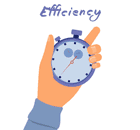The Importance of Continuous Improvement in Scrum Agile Methodology
Continuous improvement in Scrum Agile methodology is the key to streamlining processes, increasing productivity, and ensuring quality products. Keep reading to learn more about the necessity of continuous improvement in Scrum.

Scrum has become a popular Agile methodology for managing projects uniquely and smartly. Organizations using Scrum have acknowledged faster time-to-market, quality releases, and improved ROI. However, it is not just about implementing the best project management methodology for the best results. Despite being a well-structured methodology, Scrum still requires continuous improvement to yield optimal outcomes. Therefore, this article intends to discuss in detail the importance of continuous improvement in Scrum, including how to create a continuous improvement culture in the organization.
What Does Continuous Improvement Mean in Scrum Agile Methodology?
Continuous improvement in Scrum refers to the incremental approach of evaluating, refining, and optimizing the Scrum-based processes. It is based on the Japanese concept of "Kaizen", which implies making small iterative improvements continuously.
Continuous improvement is an integral part of Scrum Agile methodology. It encourages the Scrum teams to adopt a learning mindset and improve their current project development processes by identifying bottlenecks, removing waste, and improving the efficiencies of all Scrum events and processes.
In Scrum, the continuous improvement aspect is mainly addressed in the "Sprint Retrospective" meeting, which is conducted at the end of every sprint. This meeting provides a great opportunity for the Scrum team to look into its inefficiencies and set the action plan for upcoming sprints.
Besides Sprint Retrospective, the continuous feedback loop in Scrum also contributes to continuous improvement. In short, Scrum incorporates continuous improvement in almost all aspects of its operations. So, it is up to the team how it manages to utilize this concept and make incremental improvements to achieve better outcomes.
Importance of Continuous Improvement in Scrum Agile Methodology
Continuous improvement in Scrum Agile methodology is not a choice but a necessity for Scrum teams. The below points reflect the importance of continuous improvement in Scrum:
1. Streamline Workflows
Continuous improvement in Scrum is a way for teams to streamline their workflows, especially for new Scrum teams. While deploying Scrum in project management, many inefficiencies, unnecessary steps, or bottlenecks are not prominent clearly. When a team enforces a continuous improvement culture, they are able to gradually identify and eliminate wastes and inefficiencies in their processes, leading to streamlined workflows and efficient project execution.
2. Boost Scrum Team's Productivity and Efficiency
Continuous improvement initiatives help teams address the hurdles they face in Scrum. For instance, if the team cannot complete the sprint backlog within the sprint duration, continuous improvement provides a framework to identify and address the underlying causes of this issue. Therefore, the continuous analysis of the team's current processes, practices, and potential hurdles eventually boosts the Scrum team's productivity and efficiency.
3. Turns Failures into Success
Failures are a learning opportunity for Scrum teams who adhere to continuous improvement practices. When something is not going right, the Scrum team can pinpoint the root causes and make a new action plan to avoid a similar situation in the future. Afterward, the continuous assessment and iterative improvement approach turn failures into successes.
4. Reduce Project Costs
When Scrum teams continuously evaluate their workflows, remove wastes, and increase their efficiency iteratively, it leads to efficient use of resources. This includes reduced reworks and unnecessary expenses, which leads to reduced project costs and improved return on investment (ROI).
5. Quality Products & Customer Satisfaction
Continuous improvement sets a well-structured feedback loop that allows Scrum teams to analyze their development process continuously. The feedback loop incorporates both the internal feedback during daily standup meetings and sprint retrospectives and the external feedback from stakeholders/customers during sprint review meetings. All the feedback the team gathers helps to improve processes, leading to quality products and customer satisfaction.
6. Increase Sharing of Skills and Knowledge
Continuous improvement in Scrum Agile methodology is not possible without an environment of open communication and collaboration. All team members participate and contribute their expertise and knowledge in addressing bottlenecks and optimizing workflows. This collaborative environment increases the sharing of skills and knowledge, leading to a culture of learning and growth.
7. Increased Competency with Faster Time to Market
The present fast-paced business era demands organizations to ensure faster time to market and remain competitive with top-notch operational efficiency. Continuous improvement is the key to gradually making the development team productive, agile, efficient, and capable of delivering high-quality products in shorter time frames with streamlined processes.
How to Create a Culture of Continuous Improvement
Now that we know the cruciality of continuous improvement in Scrum, let's shift our focus to how to embrace a culture of continuous improvement. Although if a Scrum team adheres to all the core principles and best practices of Scrum, it is already on the right track towards continuous improvement. However, there are additional steps that can be taken to further cultivate and strengthen this culture:
1. Emphasize Sprint Retrospective
One of the keys to embracing the culture of continuous improvement is to emphasize sprint retrospectives. Once the sprint is completed, the sprint retrospective meeting provides an opportunity for the team to improve the development process and enhance the team's productivity.
In a sprint retrospective meeting, the team:
- Review the practices followed in the current sprint.
- Analyze what went well and wrong.
- Pinpoint the problems faced in the sprint.
- Develop a new action plan to improve processes for the next sprint.
This way, it is recommended that Scrum teams regularly conduct sprint retrospective meetings after every sprint to embrace continuous improvement in their processes.
2. Establish a Regular Feedback Loop Internally & Externally
Scrum makes feedback an internal part of its processes. During sprint execution, daily standup meetings provide the team an excellent opportunity to address the obstacles and improve their operations. After the sprint, the sprint review meeting empowers teams to get feedback about the product increment from stakeholders/customers.
The continuous feedback loop not just helps to address the changing demands of customers but also helps teams to look into the efficiencies of their processes and make adjustments accordingly. Therefore, Scrum teams should establish a regular feedback loop to uplift the culture of continuous improvement.
3. Focus on Iterative Improvements
Continuous improvement is an ongoing process with no final destination. Therefore, instead of setting larger goals or taking big steps, emphasize smaller, achievable improvements. For instance, if the team is spending more time estimating product backlog using Planning Poker, they can set the goal to test out another estimation technique, like Async Poker, next time to reduce the time spent. Moreover, focusing on iterative improvements can lead to more valuable outcomes in the long run.

Async Poker for Jira

Sync Poker for Jira
4. Create a Safe Environment to Experiment with New Ideas
Experiments are another driving factor in achieving continuous improvement. Scrum empowers teams to be self-organized, so they must also be provided an environment to experiment with new ideas freely without judgment. This way, team members can test different ideas to optimize processes, elevating the continuous improvement environment.
5. Track Progresses
To know the effectiveness of continuous improvement measures, the teams should use metrics and data to track the progress. This helps to identify what are the areas that require improvements. Moreover, it also provides a way to witness the fruitful impacts of continuous improvement, which further boosts the team's morale and commitment.
6. Celebrate Successes
Celebrating successes is also linked with further growing the culture of continuous improvement. Teams should celebrate when they achieve milestones and must also acknowledge the valuable contributions of team members.
7. Don't Give Up
Improving the efficiency of Scrum processes requires time and dedication. Even by following all the above steps, some teams might not be able to witness noteworthy improvements. However, it does not mean the team should lose hope. Experts recommend iterating the plan until the team finds a way that works best for it. So, the team should keep reviewing outcomes and improving its approaches steadily.
Wrapping Up
Scrum Agile methodology takes time to master, as it involves different roles, responsibilities, and processes. So, Scrum teams must continuously evaluate their processes to address bottlenecks and enhance their operations. Therefore, a culture of continuous improvement in Scrum is very vital in today's competitive business era. To sum up, do embrace the continuous improvement culture in your organization to make teams more productive, processes more efficient, and customers more satisfied.




